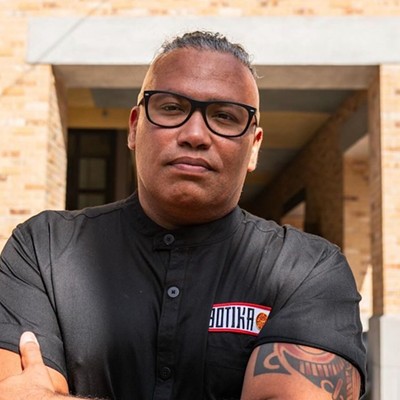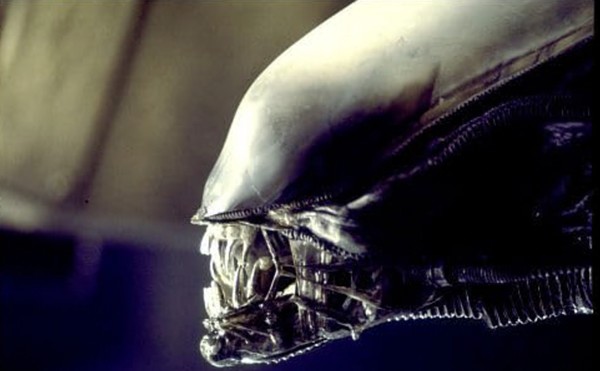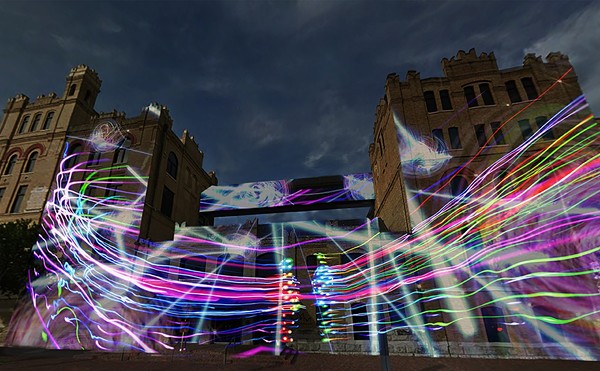David Shelton opened his eponymous Stone Oak gallery a year ago, but has yet to mount a solo show (although next month he’ll break this streak with Alejandro Diaz’s Just in Queso). He seems to delight in bringing together unusual groupings of artists, and Good and Well, currently on view, is a prime example. Mimi Kato’s digital compositions, steeped in Japanese culture, play alongside kitschy sculptural assemblages by Leslee Fraser and abstract paintings by Aaron Hans Forland. But somehow, the installation feels natural as the three very distinct formal and conceptual approaches play off of, and enhance, one another.
Shelton planned the exhibit around two pieces by Mimi Kato. “One Afternoon,” which had been exhibited in a different format as part of Artpace’s WindowWorks program in 2009, is a large triptych illustration of a Japanese neighborhood, composed using a computer. The neighborhood’s streets, windows, sidewalks, and roofs are filled with women talking, laughing, fighting, and working. A number of the characters are people dressed as bunnies and foxes. All of the characters are photographs inserted into the composition, and all of them are actually images of the artist dressed (and sometimes undressed) to depict her subjects. The other piece, mounted on the opposite wall in four frames, uses the same illustration techniques, but follows the compositional approach of traditional Japanese landscape scrolls depicting the four seasons (compare it to Sesshu’s “Landscape of the Four Seasons”). It is simply titled “Four Seasons,” and was also first shown in 2009, at Conduit Gallery in Dallas.
Kato’s penchant for inserting herself into her work tempts the viewer to think of Cindy Sherman’s photographs of herself playing stereotypical movie characters, while Kato’s illustration style and dense contemporary Japanese aesthetic call to mind Kaikai Kiki artists such as Chiho Aoshima. But these comparisons are only skin deep. Where Sherman crafted biting social critiques with her photographs, Kato’s work seems to spring from an older dramatic impulse: the desire to create characters that people can relate to and laugh at. And her all-over narratives and colorful, cartoony style differ from the fantastical pop-culture hall of mirrors found in works by Aoshima and Mr. due to Kato’s deep involvement with the real world. She may be making bright illustrations, and she may be playing hundreds of roles, some of them quite comical, but one of the most striking aspects of these works is their refreshingly quotidian nature. Characters perform everyday tasks like going to a restaurant, taking a shower, putting out the trash, chasing rabbits out of the garden. In this way, Kato’s engaging compositions are deeply rooted in the honesty and humor that can be found in Japanese aesthetic traditions, while feeling fully contemporary in their execution.
In the space between Kato’s large pieces, Aaron Hans Forland and Leslee Fraser share a wall. To the right, Fraser’s “I Wanted to Believe” features a little ceramic bunny with an almost demented expression of glee on its face as it looks over at a glass top hat, out of which knotted handkerchiefs emerge, embroidered with the words “I See.” The whole thing sits on a blandly stylized wooden shelf jutting from the wall. To the left, another of Fraser’s assemblages is displayed on a glass shelf: clear glass vessels (a tumbler, a shot glass, a few vases, a decanter) are arranged carefully. Upon close inspection, a phrase that has been etched into the glass in various fonts becomes legible: “It’s nothing” (or perhaps “It’s no thing”).
Between these two pieces, Shelton has hung three examples of Forland’s recent foray into glass-vessel sand painting. Forland likes to walk the tight-rope between minimalism and expressionism, and for years has been making paintings of usually horizontal multicolored stripes, which often look as though they have decayed through some natural process, or been disrupted by random graffiti. The interplay of colors and the wabi-sabi textures erases the sense of austerity that would otherwise dominate the work (several small versions of these paintings are also on display in Good and Well). With these glass test tubes filled with stripes of sand, and suspended from wooden brackets, he has taken his familiar style and boldly moved it into the realm of kitsch. This move fortuitously dovetails with Fraser’s approach, which involves scouring the ceramic-figurine underground for the perfect little kitties and bunnies and cute girls in white dresses with which to skewer the most unreflective elements of American culture. Fraser reveals the hidden aggressions and self-doubts lurking behind the facade represented by M.I. Hummel and its imitators.
The playfulness and wit of Fraser’s work interacts well with Kato’s characters, although they seem to be separated by their intentions — Fraser seems much more interested in social critique. Their connection to Forland, though, is purely formal. His palette invites a comparison to Kato, while his materials, and to a limited extent his approach, engage more with Fraser. By bringing these artists together, Shelton demonstrates how a strong eye can tease the affinities out of divergent artwork, and how an art collection can be strengthened by textural and conceptual contrasts as much as by the threads that run through it. •
Ben Judson works on the David Shelton Gallery website as an independent contractor.
Good and Well
Jun 12
David Shelton Gallery
210) 481-5200
davidsheltongallery.com

















